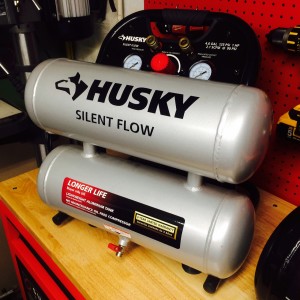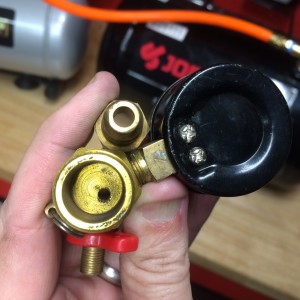Small compressors are great for many uses — since typically they are lightweight, portable, and run off of standard wall power.
But, where there are positive features, there are always negatives. Inevitably, you will run into situations where your otherwise useful compressor just wont work (or work efficiently) due to a lack of a sufficient air supply. One thing that immediately comes to mind will be with some high CFM use tools such as an impact wrench. The compressor just cant produce enough air to run most of them & you will be stuck doing things (like rotating tires) by hand.

Trying to justify the upgrade cost to go from your stacked or pancake compressor — up to a full size unit — just isnt realistic in many cases. That could easily be another $200-$300, and for the DIYer/Homeowner who just does minimal vehicle maintenance — it definitely doesn’t make sense.
Something to consider would be to add an auxiliary tank (in-line) which will greatly increase the storage capacity of the compressed air, and will allow you to easily complete tasks that the compressor along just cannot do. This can be achieved with a short list of items from your local home center, and with minimal effort can be assembled in a few minutes.
What you will need are the following items :
- Portable Air Tank (125 psi minimum rating)
- 1/2″ to 1/4″ NPT Bushing
- 1/4″ T-fitting
- 1/4″ Coupler
- 1/4″ Plug
- 3′ section of “lead hose”
- Thread Tape
Start out by removing the entire (factory installed) air valve assembly from the portable air tank. Usually this will include a hose, valve, and pressure gauge. Unfortunately the stock valve assembly cannot be re-used for our build, since the flow-rate would be very low due to the extremely small hole feeding through the valve. Compared to a standard 1/4″ NPT plug — the difference is very noticeable.

Next you will need to install the 1/2″ to 1/4″ bushing into the tank opening, the t-fitting will screw into that, and then on either side of the t-fitting will be the coupler & lead hose. On the opposite side of the lead hose, install the 1/4″ plug. Now you are ready to connect everything up to the main compressor and pressure test it for leaks. Be sure to assemble each piece with thread tape — otherwise it will not have a tight seal. Also be mindful not to over-tighten, or the thin brass fittings will crack or split!
Connecting the Husky Silent Flow compressor to the auxiliary tank has now more than doubled the storage capacity — increasing from the stock 4.6 gallons, to now 9.6 gallons (due to the 5 gallon extra tank). This will vary for you — depending on your compressor tank size & auxiliary tank size.
Running both scenarios through a lug nut test, the results speak for themselves. Our test vehicle is a Honda Pilot, with tires that were last rotated 4 months ago (10,000 miles). We are using a Chicago Pneumatic stubby impact wrench, 50′ of 3/8″ ID air line, and 1/4″ NPT fittings.
- Test #1 (4.6 gallon compressor ONLY) = 2nd lug nut the compressor kicked on due to low pressure.
- Test #2 (9.6 gallon compressor/tank combo) = 5th lug nut fully removed & compressor kicked on as tanks equalized in pressure. The impact also seemed to have more power (we assume due to higher flow fittings coming out of the auxiliary tank VS the restrictions on the compressor only).
So, proven in testing is the fact that more air = more work done. Keep in mind that the downside to this will be double cycle times for the compressor. This is due to it having to fill up it’s main tank(s) & also the auxiliary tank -VS- only filling up it’s main tank. But, for the occasional user that just needs more air, this is absolutely the way to go.
We ended up buying the tank, fittings, and lead hose for under $30 locally — and to buy a 10 gallon compressor would have been many times that. This allows you to have a bigger compressor when needed, and then use it as you typically would the rest of the time!


